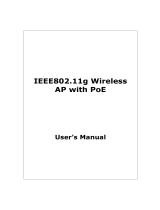
© Copyright 2017 TRENDnet. All Rights Reserved.
Table of Contents
Product Overview ........................................................................... 1
Package Contents .......................................................................................................... 1
Features ......................................................................................................................... 1
Product Hardware Features........................................................................................... 2
Application Diagram ...................................................................................................... 3
Getting Started .............................................................................................................. 4
Steps to improve wireless connectivity ......................................................................... 5
Connect wireless devices to your access point .............................................................. 6
Configuration .................................................................................. 6
Wireless Networking and Security ................................................... 9
How to choose the type of security for your wireless network .................................... 9
Secure your wireless network ..................................................................................... 10
Connect wireless devices using WPS ........................................................................... 12
Advanced configuration ................................................................ 13
Access the management page ..................................................................................... 13
Operating Modes ......................................................................................................... 14
Access Point .................................................................................. 15
Basic ............................................................................................................................. 15
Wireless Profile ............................................................................................................ 16
Wireless MAC filter ...................................................................................................... 17
Band Steering............................................................................................................... 17
Airtime Fairness ........................................................................................................... 18
Roaming Support (802.11k) ......................................................................................... 18
RSSI Scanner ................................................................................................................ 19
IPv6 Settings ................................................................................................................ 19
Static IPv6 .................................................................................................................... 20
Auto Configuration (SLAAC/DHCPv6) .......................................................................... 20
Change your IP address ............................................................................................... 20
Captive Portal .............................................................................................................. 21
Captive Portal with RADIUS (CoovaChilli) .......................................................... 21
Internal Captive Portal ....................................................................................... 22
Redirect URL ...................................................................................................... 26
Create schedules ......................................................................................................... 28
Configure Spanning Tree ............................................................................................. 28
Set date and time ........................................................................................................ 29
Daylight Saving Time ................................................................................................... 29
NTP .............................................................................................................................. 29
Manual ......................................................................................................................... 29
Manage VLAN .............................................................................................................. 29
Traffic Shaping ............................................................................................................. 30
Enable SNMP ............................................................................................................... 30
Enable CLI .................................................................................................................... 31
LED Controls ................................................................................................................ 31
Client Bridge ................................................................................. 32
Basic ............................................................................................................................. 32
Scan for wireless networks .......................................................................................... 33
WDS ............................................................................................. 34
WDS Link ...................................................................................................................... 34
Basic ............................................................................................................................. 35
Wireless Profile ............................................................................................................ 36
Repeater ....................................................................................... 37
Basic ............................................................................................................................. 37
Scan for wireless networks .......................................................................................... 38
Advanced wireless settings ......................................................................................... 38




















